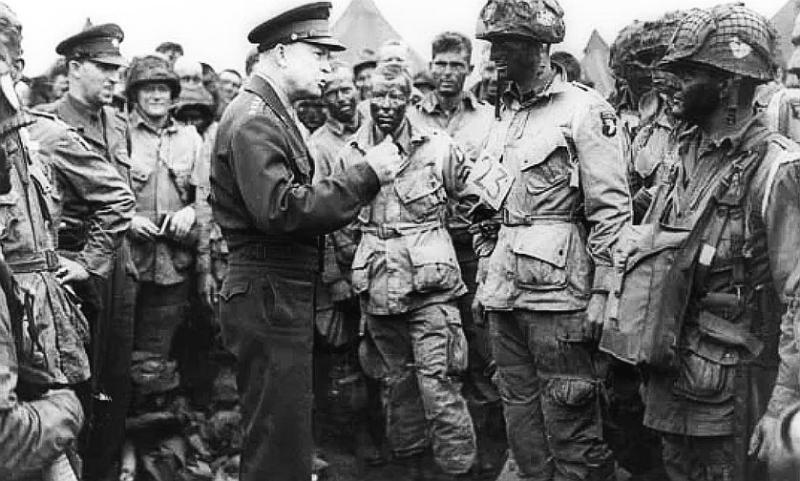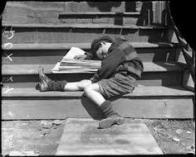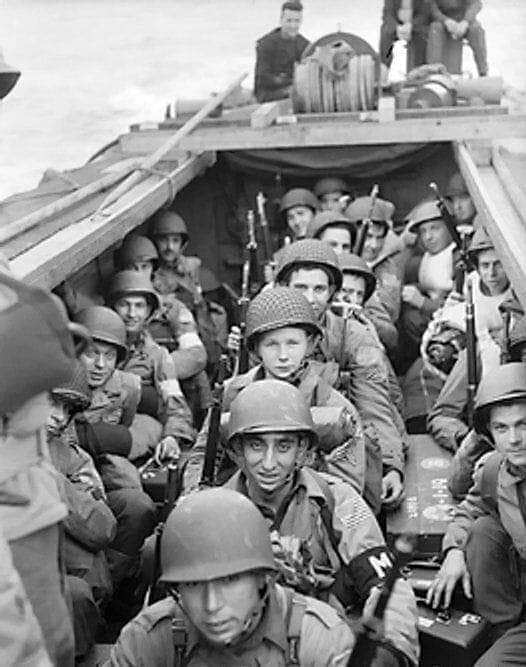"Soldiers, Sailors and Airmen of the Allied Expeditionary Force!"


In company with our brave Allies and brothers-in-arms on other Fronts, you will bring about the destruction of the German war machine, the elimination of Nazi tyranny over the oppressed peoples of Europe, and security for ourselves in a free world."

"Soldiers, Sailors and Airmen of the Allied Expeditionary Force!"
"You are about to embark upon the Great Crusade, toward which we have striven these many months. The eyes of the world are upon you. The hopes and prayers of liberty-loving people everywhere march with you. In company with our brave Allies and brothers-in-arms on other Fronts, you will bring about the destruction of the German war machine, the elimination of Nazi tyranny over the oppressed peoples of Europe, and security for ourselves in a free world."
— Excerpt from Supreme Allied Commander Dwight D. Eisenhower's Order of the Day for June 6, 1944


allied planes bomb Pointe Du Hoc
-

assault on omaha beach
-

u.s. troops at utah beach
-



Less than 1% of the American troops that participated in D-Day are still alive.
Arvo John..
And when the last one has fallen, the hands of time will stop..
The living history they represent, will be forever stilled...🥀🥀
Australian members of No. 196 Squadron RAF with one of the unit's Stirling aircraft in the background. This squadron towed gliders to Normandy on D-Day.
Evening John...there were Kiwis flying as well on D Day..
And Canadians.
They liberated Europe. They saved the world. They provided us with the life we are able to have today. They truly were the Greatest Generation. Eternal thanks.
And what a generation they were....
Rudders Rangers, the Boys of Pointe Du Hoc the 2nd Ranger Battalion scaled 100 foot cliffs under intense enemy fire.
Truly, the Greatest Generation.
Arvo...
I only found out today that 3,200 Aussies were involved in D Day...has never really been mentioned here before and just assumed it was American British and Canadians involved...
No matter what country they came from in the D Day landing..
Lest we forget..
Other participants in D-Day were allies from Belgium, Czechoslovakia, Denmark, France, Greece, the Netherlands, New Zealand, Norway and Poland, all countries, except New Zealand, which were under Nazi occupation.
from Delivered From Evil by Robert Leckie
When Brig. Gen. Norman (Dutch) Cota arrived on Omaha with his 29th Division command group at 7:30 a.m., he found chaos and paralysis. He saw a soldier shot down who wept and cried for his mother. He saw another apparently on his knees praying, but when he came closer, he saw that he was dead, his face frozen in terror. Two of his group were killed within three feet of him, while another was hurled twenty feet by a shell blast. Cota moved among his dazed troops, compelling junior officers to lead their men forward, searching for openings from the beach. Coming upon a group of pinned-down Rangers, he asked who they were. “Rangers!” came the reply. “Then, goddamnit, if you’re Rangers, get up and lead the way!” Stung, they leaped erect and began blasting paths through the German wire with bangalore torpedoes. Infantrymen lurched through them. The road at the top of the cliff was reached.
Americans had gotten behind some of the Germans’ strongest positions, killing the enemy or taking them prisoners. By 11 a.m. the 29th took Vierville. Cota found an abandoned bulldozer loaded with TNT desperately needed on the beach to blow obstacles. He yelled angrily for a volunteer to drive it. A red-haired soldier stood up. “I’ll do it!” he cried, and climbed into the driver’s seat. When Cota found another group of Rangers apparently pinned down, he deliberately walked ahead of them to show that there was no enemy lire. There was, but it didn’t kill Cota, and because the Americans had such men—soldiers who did not point the way but cried, “Follow me!”—the near-disaster that had been Omaha was reversed and all along the line the 1st and 29th pressed forward. At 1:30 p.m. a vastly relieved Omar Bradley read Gerow’s message: “Troops formerly pinned down on beaches Easy Red, Easy Green, Fox Red advancing up heights beyond beaches.”
Very moving and sobering photo.
Thanks for the article, John. I hope this country never forgets those who landed on that beach that day and the lives that were lost
This I believe is the second seed on D-Day. I try to respect those who post these seeds. I can't believe the first seed is no longer on the front page.

At any rate, I thought I'd post my 2 cents worth:
90% of the soldiers on the first boats to hit the beach didn't live to see the end of the day.
No whining from that generation.
Please dont whine on D Day.
Take the decent treatment and sit still.
Evening...the lad in the middle row 3rd from the front looks about 14..
How in the heck anyone survived D Day is a miracle...
A truly remarkable generation of service men and women, never to be seen again...
I was thinking the same thing. I wonder if he is one of the survivors?
Morning Just...and if he did was he ever the same again after going through that...
And that applies to any war, old or modern...
What you see and hear, don't think I would..my grandfather was in WW1..in France and on the Somme. He never spoke about it..was shot twice but still went back..
[✘]
“Believe me, Lang, the first twenty-four hours of the invasion will be decisive … for the Allies, as well as Germany, it will be the longest day.”
― Cornelius Ryan, The Longest Day: The Classic Epic of D-Day
“Many grew introspective and talked of things men usually keep to themselves. Hundreds later recalled that they found themselves admitting their fears and talking of other personal matters with unusual candor. They drew closer to one another on this strange night and confided in men they had never even met before.”
― Cornelius Ryan, The Longest Day: The Classic Epic of D-Day
“Across the nation, in sleeping towns and villages, lights flashed on. Quiet streets suddenly filled with sound as radios were turned up. People woke their neighbors to tell them the news, and so many phoned friends and relatives that telephone switchboards were jammed. In Coffeyville, Kansas, men and women in their night attire knelt on porches and prayed.”
― Cornelius Ryan, The Longest Day: The Classic Epic of D-Day
It is always tough to make a docu-drama like that. They pulled it off fairly well, giving the audience a worm's eye view.
For those wanting additional info:
An excellent hour by hour replay:
D-Day and the Normandy Campaign
“BUILDUP AND TRAINING
The planning for an invasion in northwest Europe began years in advance, although it was not until December 1943, when General Dwight D. Eisenhower was appointed Supreme Commander of the Allied Expeditionary Force, that preparations for the future operation, code-named Overlord, intensified.
THE PLAN
Operation Fortitude successfully deceived German High Command into expecting a landing at Pas-de-Calais. Instead, the Allies targeted a 50-mile stretch of Normandy coastline. The plan had two components: Operation Neptune, the naval assault phase, and Operation Overlord, the broader invasion strategy. Approximately 160,000 Allied troops were to land across five beaches: Sword, Juno, Gold, Omaha, and Utah, with British and American airborne forces landing inland.
FEATURED ARTICLE
D-DAY
Initially set for June 5, D-Day was delayed due to poor weather. With a small window of opportunity in the weather, Eisenhower decided to go—D-Day would be June 6, 1944. Paratroopers began landing after midnight, followed by a massive naval and aerial bombardment at 6:30 a.m. American forces faced severe resistance at Omaha and Utah Beaches. Despite challenges, including mislandings and fierce opposition, Allied forces established a critical beachhead in Normandy.
HEDGEROW FIGHTING
For all of the preparations made for Overlord, the Allied forces were ill-equipped to fight in the hedgerows they quickly encountered in Normandy. The Normandy bocage presented unexpected challenges with its dense hedgerows and narrow roads. German forces used the hedgerows defensively, creating deadly killing fields that Allied troops had to cross. The Allies had to adapt their tactics to overcome these obstacles and advance.
THE END OF THE NORMANDY CAMPAIGN
American forces isolated and captured Cherbourg by June 27, while British forces secured Caen by July 9. Despite these victories, progress was slow. On July 24–25, American forces launched Operation Cobra, breaking through German lines near Saint-Lô. This marked the end of the Normandy Campaign and the beginning of the Allied push to liberate northern France and Paris.”
The National Museum of the US Army :
The National WWII Museum :
The D-Day Memorial :
The US Army Center of Military History :
The Bazooka :
The Higgins Boat :
The Parachute :
The Sherman Tank :
Thank You JR
Never forget.
Courage that is hard to fathom from the men who jumped in the middle of the night into occupied territory and who stormed fortified beaches.
Actual heroes.
When the 101st Airborne was preparing to leave the US as a new unit their commanding General Lee gave a speech and in it were the words, ''The 101st has no history but we have a rendezvous with destiny.''
Those words would be proven true at Normandy and one of the 101st finest moments, Bastogne, Belgium where the ''Battling Bastards'' stopped the German counterattack at the Battle of the Bulge in freezing weather, running out of food and ammo they held with the immortal words to the German commander when they were asked to surrender or be annihilated, General McAuliffe replied, ''NUTS.''
Bless all who sacrificed to pay the cost of freedom.